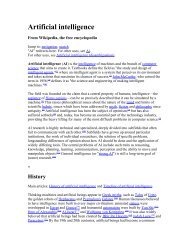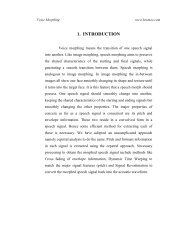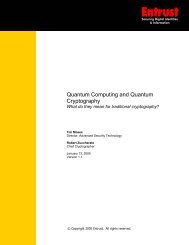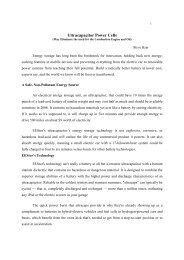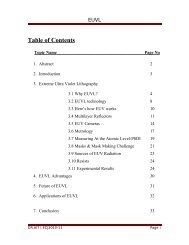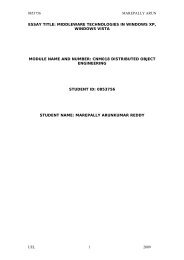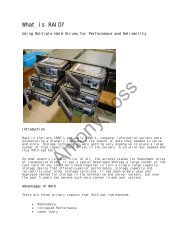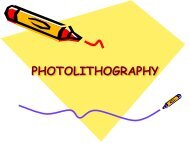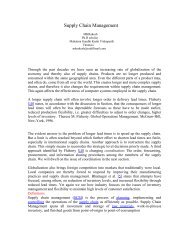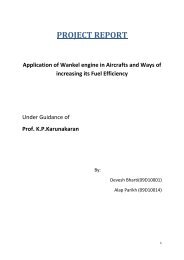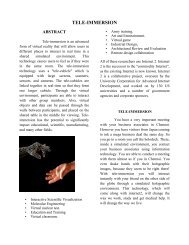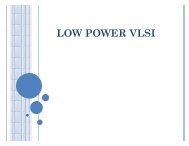Plasmonic organic solar cell.pdf - 123SeminarsOnly
Plasmonic organic solar cell.pdf - 123SeminarsOnly
Plasmonic organic solar cell.pdf - 123SeminarsOnly
Create successful ePaper yourself
Turn your PDF publications into a flip-book with our unique Google optimized e-Paper software.
6<br />
obtained by using a spin-coating method to spread the colloidal<br />
nanoparticles on wide areas of organosilane-coated silica substrates.<br />
Enhanced absorptance up to 50% was obtained for a bulk heterojunction<br />
layer including these nanospheres. Power density of the<br />
electromagnetic field computations confirms that an increased<br />
absorptance and increased concentration of the power are possible<br />
in the vicinity of a two-dimensional array of nanoparticles embedded<br />
in the BHJ. Preferential distributions of the electromagnetic field in<br />
the longitudinal and transversal planes with respect to the nanoparticles<br />
2D-grating are shown. Both effects, the increase of the local<br />
field strength and the internal light scattering, can contribute to<br />
stronger absorption. The investigation has to be completed by optical<br />
measurements in order to separate the contribution to the global<br />
absorption from possible external scattering. The best positioning of<br />
these nanoparticles in a multilayer <strong>organic</strong> <strong>solar</strong> <strong>cell</strong> has to be<br />
analyzed in order to maintain the strong benefit of the localized<br />
surface plasmons on absorption without degrading the electrical<br />
properties, and thus to obtain a significant photovoltaic power<br />
efficiency improvement.<br />
Acknowledgements<br />
The authors acknowledge C. Defranoux from SOPRA S.A.<br />
company (Bois Colombes-France) for spectroscopic ellipsometry<br />
measurements of MEH-PPV:PCBM, and Agence Nationale de la<br />
Recherche (ANR) for support under the photovoltaic program<br />
SPARCS (ANR-07-PSPV-006-02).<br />
References<br />
[1] F. Flory, L. Escoubas, B. Lazarides, Artificial anisotropy and polarizing films,<br />
Appl. Opt. 41 (16) (2002) 3332–3335.<br />
[2] F. Monestier, Ph. Torchio, J.J. Simon, L. Escoubas, M. Cathelinaud, Demonstration<br />
of a software for automatic optimization of the electromagnetic<br />
ARTICLE IN PRESS<br />
D. Duche et al. / Solar Energy Materials & Solar Cells ] (]]]]) ]]]–]]]<br />
field in <strong>organic</strong> <strong>solar</strong> <strong>cell</strong>s, Nonlinear Opt. Quantum Opt. 37 (2007)<br />
159–168.<br />
[3] F. Monestier, J.J. Simon, Ph. Torchio, L. Escoubas, F. Flory, S. Bailly, R. de<br />
Bettignies, S. Guillerez, C. Defranoux, Modeling the short circuit current<br />
density of polymer <strong>solar</strong> <strong>cell</strong>s based on P3HT:PCBM blend, Sol. Energ. Mater.<br />
Sol. Cells 91 (2007) 405–410.<br />
[4] D. Duche, L. Escoubas, J.J. Simon, Ph. Torchio, W. Vervisch, F. Flory, Slow blochmodes<br />
for enhancing the absorption of light in thin films for photovoltaic<br />
<strong>cell</strong>s, Appl. Phys. Lett. 92 (2008) 193310.1–193310.3.<br />
[5] W.L. Barnes, A. Dereux, T.W. Ebbesen, Surface plasmon subwavelength optics,<br />
Nature (London) 424 (2003) 824–830.<br />
[6] D. Derkacs, S.H. Lim, P. Matheu, W. Mar, E.T. Yu, Improved performance<br />
of amorphous silicon <strong>solar</strong> <strong>cell</strong>s via scattering from surface plasmon<br />
polaritons in nearby metallic nanoparticles, Appl. Phys. Lett. 89 (2006)<br />
093103.1–093103.3.<br />
[7] S. Pillai, K.R. Catchpole, T. Trupke, M.A. Green, Surface plasmon enhanced<br />
silicon <strong>solar</strong> <strong>cell</strong>s, J. Appl. Phys. 101 (2007) 093105.1–093105.8.<br />
[8] D.M. Schaadt, B. Feng, E.T. Yu, Enhanced semiconductor optical absorption via<br />
surface plasmon excitation in metal nanoparticles, Appl. Phys. Lett. 86 (2005)<br />
063106.1–063106.3.<br />
[9] O. Stenzel, A. Stendhal, K. Voigtsberger, C. von Borczyskowski, Enhancement<br />
of the photovoltaïc conversion efficiency of copper phthalocyanine thin film<br />
devices by incorporation of metal clusters, Sol. Energy Mater. Sol. Cells 37 (1995)<br />
337–348.<br />
[10] W. Westphalen, U. Kreibig, J. Rostalski, H. Lüth, D. Meissner, Metal<br />
cluster enhanced <strong>organic</strong> <strong>solar</strong> <strong>cell</strong>s, Sol. Energy Mater. Sol. Cells 61 (2000)<br />
97–105.<br />
[11] B.P. Rand, P. Peumans, S.R. Forrest, Long-range absorption enhancement in<br />
<strong>organic</strong> tandem thin-film <strong>solar</strong> <strong>cell</strong>s containing silver nanoclusters, J. Appl.<br />
Phys. 96 (12) (2004) 7519–7526.<br />
[12] A. Tavlove, Computational Electrodynamics: The Finite-Difference Time-<br />
Domain Method, Artech House, Norwood, MA, 1995.<br />
[13] J.Y. Kim, K. Lee, N.E. Coates, D. Moses, T. Nguyen, M. Dante, J. Heeger, Efficient<br />
Tandem polymer <strong>solar</strong> <strong>cell</strong>s fabricated by all-solution processing, Science 317<br />
(2007) 222–225.<br />
[14] E.D. Palik, Handbook of Optical Constants of Solids, Academic Press, New York,<br />
1985, p. 12.<br />
[15] C. Seassal, Y. Park, A. Fave, E. Drouard, E. Fourmond, A. Kaminski, M. Lemiti, X.<br />
Letartre, P. Viktorovitch, Photonic crystal assisted ultra-thin silicon<br />
photovoltaic <strong>solar</strong> <strong>cell</strong>, in: SPIE Proceedings of the Photonics Europe Conference,<br />
2008.<br />
[16] G. Mie, Beiträge zur optik trüber medien, Speziell Kolloidaler Metallösungen,<br />
Leipzig, Ann. Phys. 330 (1908) 377–445.<br />
[17] U. Kreibig, M. Vollmer, Optical Properties of Metal Clusters, Springer, Berlin,<br />
1995.<br />
Please cite this article as: D. Duche, et al., Sol. Energy Mater. Sol. Cells (2009), doi:10.1016/j.solmat.2009.02.028



